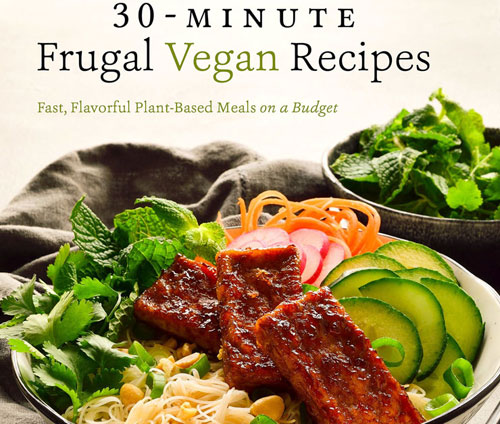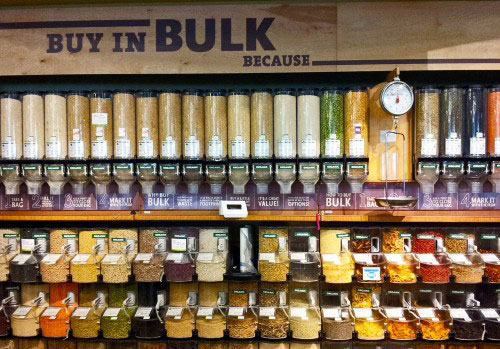5 Ways I’ve Made A Plant-Based Diet More Budget-Friendly
Melissa Copeland is the creator of the popular vegan food blog The Stingy Vegan, where she specializes in healthy, delicious cooking on the cheap. She’s also the author of the book 30-Minute Frugal Vegan Recipes, featuring budget-friendly, plant-based meals for the busy home cook. Following we present an excerpt with her top five strategies for going vegan without breaking the bank.

If I had a cashew for every time I heard the old “I’d like to go vegan, but it’s just so expensive” excuse, I’d be bathing in cashew cream. There’s a pervasive myth that a vegan diet is not only more expensive and complicated than the standard American diet, but that you need to do all your grocery shopping in special organic-only health food stores or from the dedicated vegetarian fridge at your local supermarket (the “but my supermarket doesn’t have vegan options” excuse is another one that drives me up the wall).
It’s easy to see how many people perceive veganism as expensive. For those who are transitioning from a standard American diet toward a plant-based one, the fake ground meat crumbles and vegan cheeses often seem like the easy way to eat less meat while still cooking their favorite and familiar recipes – but these products are expensive, and if you base your diet around them, the costs will quickly add up.
What’s not true, however, is that your supermarket doesn’t have vegan options. The pillars of a healthy, hearty, and delicious vegan diet are beans, rice, and vegetables (and maybe nutritional yeast and bananas). These can be some of the cheapest items in your supermarket, and – as I do in all my recipes – you can doctor them up with seasonings, sauces, and cooking methods that make them anything but boring. Seriously, you’ll never look at a chickpea the same way again – chickpea breakfast sandwich, anyone?
Here, I’m going to give you some of my favorite money- and time-saving tips and tricks for eating a healthy, delicious vegan diet on a budget. Many of them may seem obvious because they are – grocery shopping and food prep are not rocket science. But if you’re looking to reduce your grocery bill and save time in the kitchen, you might need to change some habits and approach shopping and cooking a bit differently.
1. Learn how to really cook with vegetables.
Yes, you can make a hearty and satisfying meal for the whole family without following the “meat and two veg” formula – you just need to have a few recipes at hand. Follow vegan food blogs, join vegan social media groups, and check out a few vegan cookbooks at your local library. Try recipes you’ve never tried before, try the veggie dishes at your local restaurants, and, most important, keep an open mind. You think you hate tofu or tempeh now? Just wait till you’ve tried it coated in arrowroot powder, pan-fried until crispy, and bathed in a delicious sauce! (This tempeh and broccoli stir-fry will make you a believer.)
2. Buy in bulk.
This one is a no-brainer. Bulk food stores and the bulk food section of supermarkets are almost always cheaper for beans, pasta, flours, nuts, seeds, and grains than prepackaged products. Also, if you’ve got a recipe for an unfamiliar ingredient, you can buy exactly what you need rather than risk buying an entire package that just sits in your cupboard taking up space.

3. Get to know your local Asian and Latin American markets.
Asian markets are great for big blocks of tofu, rice, noodles, soy sauce, miso, and coconut milk. Latin American markets have a great selection of beans, chile peppers, tortillas, and sauces. Indian markets will blow your mind with the variety of spices offered. And you’ll find all of these items at better prices than supermarkets.
4. Don’t discriminate against frozen vegetables.
I know, this one can be hard. Fresh veggies taste fresh and look nice, and frozen ones just seem like the lower-quality option. But science says that frozen veggies are just as nutritious as fresh (they’re picked at peak ripeness and flash-frozen to preserve all that nutrient-rich goodness), available year-round even when they’re not in season, and you don’t have to worry about them rotting in a week, and even organic options are almost always cheaper. Best of all, frozen vegetables save you time. No need to wash, peel, and chop them – it’s already been done for you. They’re perfect for whipping up a quick stir-fry and make a great addition to grain bowls.
5. Grow it yourself.
I’m a big proponent of growing your own. It doesn’t matter how little space you have. I live in an apartment with no balcony, and I still manage to grow a small variety of vegetables. Herbs and salad greens are super easy to grow in pots and need next to no space (just Google “container gardening”). Sprouts are even easier (and great for brain and overall health); you need no special equipment other than a jar, and they’re ready to eat in just a couple of days. If you’ve got a patio or a backyard, try your hand at tomatoes and peppers – they’re guaranteed to be the most delicious you have ever tasted!
yogaesoteric
October 14, 2019
